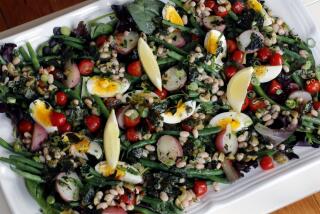For new dietary guidelines, U.S. panel looks at the whole plate
When it comes to a healthful diet, the whole is greater than the sum of its parts. That’s the new approach a nutritional advisory committee has taken in its recommendations to the federal government for the upcoming 2015 Dietary Guidelines for Americans.
Rather than focus on individual foods and nutrients, as Dietary Guidelines Advisory committees have in years past, the committee focused on overall dietary patterns that correlate with positive health outcomes.
“I think it’s a really important paradigm shift,” says Dr. Frank Hu, professor of nutrition and epidemiology at Harvard School of Public Health and member of the advisory committee. “In real life, we don’t eat isolated nutrients or foods. We eat complex meals, so it makes sense to look at the totality of diet: foods and nutrients in the combination, frequency and quantity that they are habitually consumed.”
------------
FOR THE RECORD:
Dietary patterns: In the Aug. 1 Saturday section, an article on advisors’ views on the upcoming Dietary Guidelines for Americans, 2015, misstated part of the title of Carolyn Katzin, a certified nutrition specialist and integrative oncology specialist at UCLA, as integrated oncology specialist. —
------------
The scientific report, which came out in February, analyzed a large body of studies to identify dietary patterns associated with a lower risk of heart disease, obesity, Type 2 diabetes and a variety of cancers and mental health impairments. Three eating patterns were consistently associated with good health: the healthful U.S.-style pattern, the healthful Mediterranean-style pattern and the healthful vegetarian pattern.
Though there are differences among them, they share a high intake of vegetables, fruits, whole grains, fish, legumes and nuts; a moderate intake of low-fat and nonfat dairy products and alcohol; and a low intake of red and processed meats, sugar-sweetened foods and beverages, and refined grains.
After a period of review, the official Dietary Guidelines for Americans, 2015, will come out later this year.
The actual nutrition recommendations are the same as those in the 2010 guidelines, but the approach is different, says Anna Maria Siega-Riz, professor of epidemiology and nutrition at the Gillings School of Global Public Health, University of North Carolina at Chapel Hill, and chair of the advisory panel’s subcommittee on dietary patterns.
“The benefits of looking at different patterns as opposed to single foods and nutrients are manifold,” says Siega-Riz. First, it’s much easier for people to think of what they consume over time — and modify their overall eating pattern accordingly. Second, nutrients in foods may have synergistic effects when eaten in combination, interacting to create different health effects than when eaten alone. (For example, vitamin C in dark green vegetables increases the absorption of iron from lean meat and fish; eating healthful fats with vegetables enhances the absorption of cancer-fighting phytonutrients.)
Third, because foods are eaten together, we always have to think of nutrition in terms of substitution, says Siega-Riz, pointing to studies showing that pregnant women who regularly eat fish are less likely to have preterm birth. Though it seems reasonable to conclude that the protective benefit comes from omega-3 fatty acids in the fish, researchers have found that omega-3 fatty acid supplements don’t have the same effect. “This happens in nutrition all the time. People may be eating fish, but they also may be eating less of something else, or more fruits and vegetables along with the fish.”
One of the biggest advantages to viewing diet in terms of overall pattern is that it can then be tailored to fit the needs of different individuals based on food preferences, cooking preferences and cultural traditions.
But the true test will be whether or not individuals improve the way they eat, says Carolyn Katzin, certified nutrition specialist and integrated oncology specialist at UCLA. In order to do that, she says, the dietary guidelines must be accessible. “There is so much opportunity with online interfaces and social media. I want to see graphics, pictures, something that makes the dietary patterns easy for individuals to follow.”
::
Three diet plates: U.S., Mediterranean and vegetarian
Here is a glimpse into the three patterns of eating recommended by the advisory committee:
Healthful U.S.-style
Uses staples of American food but without as much saturated fat, red meat, added sugar or refined carbohydrates as is often found in the typical American diet — and with a higher amount of fiber and nutrients. Instead of the traditional slab of meat as the centerpiece, it consists of more balanced portions. For example, a dinner plate might include roasted chicken alongside a sweet potato and an abundance of leafy vegetables topped with walnuts. A beverage could be low-fat dairy or a dairy equivalent. Dessert might be strawberries or pineapple.
Healthful Mediterranean-style
Olive oil is a main feature, along with seafood and nuts — and less pasta than people typically expect. A dinner plate might hold grilled fish drizzled in olive oil and sprinkled with almonds, sliced tomatoes and a generous serving of dark green vegetables. (A key part of the original Mediterranean diet was an abundance of wild purslane.) Whole-grain pita bread and a glass of red wine could top off the meal and, afterward, some apricot or fig slices.
Healthful vegetarian
Instead of meat, features complete protein assembled using whole grains, legumes and commonly an assortment of soy-based foods. A plate might comprise a mixture of quinoa and black beans sprinkled with a small amount of grated cheese (or soy cheese for vegans), and an abundance of vegetables, such as asparagus, broccoli and squash. Citrus fruits, such as tangerines, would make a nutritious dessert.
ALSO:
How three SoCal beach cities help clear the path for healthful choices
Your guide to L.A.’s indoor cycling scene: Here’s how SoulCycle stacks up against the rest
How one man conquered his paralyzing fear of swimming in open water (and how you can too)






